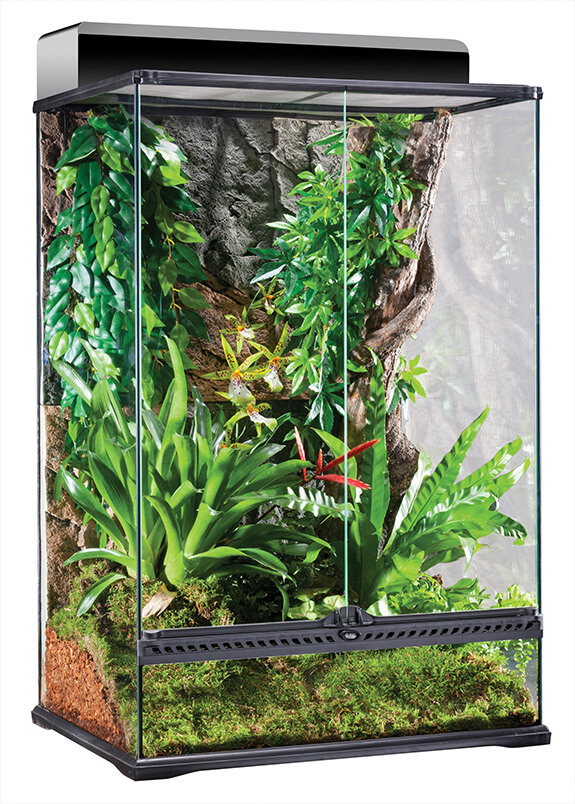Pet Lizard Habitats: The Rainforest Terrarium
Table of Contents
The most noticeable features of a rainforest terrarium are the luxuriously growing plants. They fulfill a decorative purpose and at the same time providing hunting-ground boundaries for territorial lizards.

Arrangement of Back and Side Walls
A plant wall is appropriate when light values are sufficient. Screening of plastic or stainless-steel wire (mesh gauge 0.2 to 0.6 inches 10-5 to 1.5 cm) is mounted so that there are 0-8 to 2 inches (2 to 5 cm) of space (depending on the size of the terrarium) between the wall and the screen. Fill this space with peat moss and sphagnum and press it down gently. The screening might be shaped a little as you do this, so as to give the wall an interesting structure. Then cuttings of vines or hanging plants are stuck into the peat-sphagnum mixture and fastened with wire or plastic clips.
Empty space can be filled in with peat or green sphagnum tips. Walls masked with bark, bark planks, or bamboo provide the ideal environment for species that live primarily on tree trunks. Besides, they give your pets a much larger running area. The coverings should not furnish any unreachable hiding places for lizards or for food animals. Imitation woods of plastic are not suitable for terrariums.
If the terrarium walls are glass, they will be tinted with color on the outside; if the walls are of wood or Masonite they will be sealed on all sides (including the edges) with a plastic paint. These solutions are economical and hygienic.
Epiphytes and Branches for Climbing
If you are planning to use epiphytically growing plants in the terrarium, you need the right kind of branches to hold the root balls. Branches of locust (Robinia) and lilac (Syringa) are especially suitable because the wood is not much injured by dampness. You can also use oak or the wood of stone-fruit trees. These kinds of wood are also suited for climbing branches. Evergreen branches do not have the interesting growth forms nor are they particularly long lasting. You must rule out the possibility of accidents (tipping or slipping branches, tails getting caught) by mounting the branches as follows:
- Cut the branches so that the cut surface will lie flat against the floor or the wall of the terrarium.
- Attach the branch by means of a metal corner and silicone caulk either to the glass floor or wall. If the wall is wood, you can use screws to fasten the branch firmly.
- Never mount branches so that they cross. Otherwise the lizards, especially long-tailed lizards, can catch their tails, thus injuring them.
- Don't introduce too many decorative materials or observation and access will be very difficult.
Floor Medium
The nature of the floor material influences both the humidity of the floor and the air in the terrarium. A one- (or at most two-) year-old leaf or pine-needle surface, which in larger terrariums is covered with fresh-fallen leaves, is ideal. The ground-dwelling lizards can conceal themselves in this and, if they are not overfed, search in it for food. This particular type of food-seeking demonstrates so much of lizard behavior that it justifies the additional effort to make frequent changes of leaves. (There is no other way to keep the terrarium clean.)
Water Containers
In the rain-forest terrarium, a water container isn't necessary for most lizards. They drink the water that has collected in the “cisterns” of the bromeliads or in drops on the leaves of other plants.
Species that like to swim need a water bath. It must be large enough for the largest lizard living in the terrarium to fit comfortably into. A glass or a pottery container for example, is good. You can also model a small pond with epoxy resin bonded to fiberglass cloth, or you can make a running stream driven by a rotary pump.




Leave a Reply